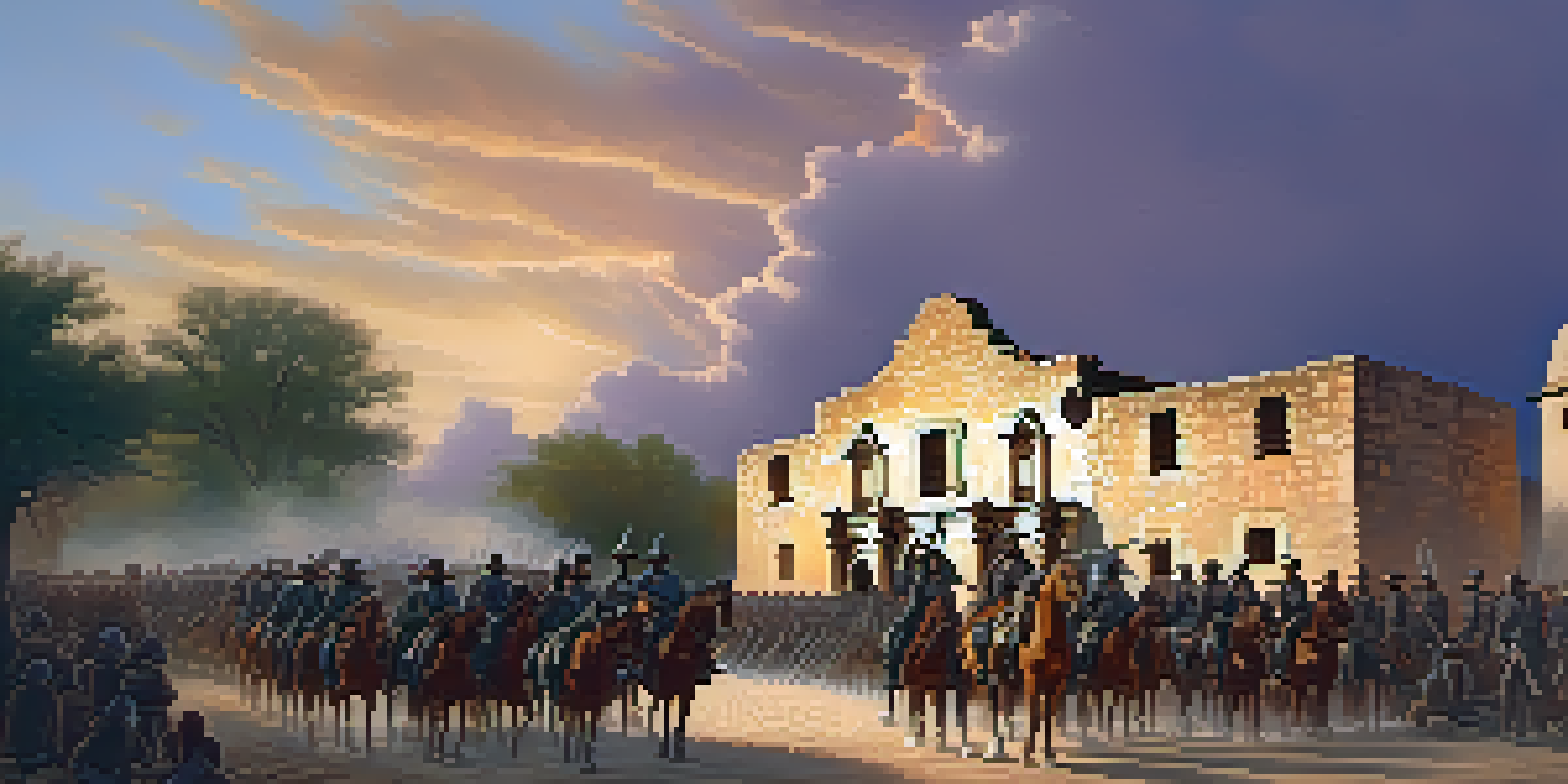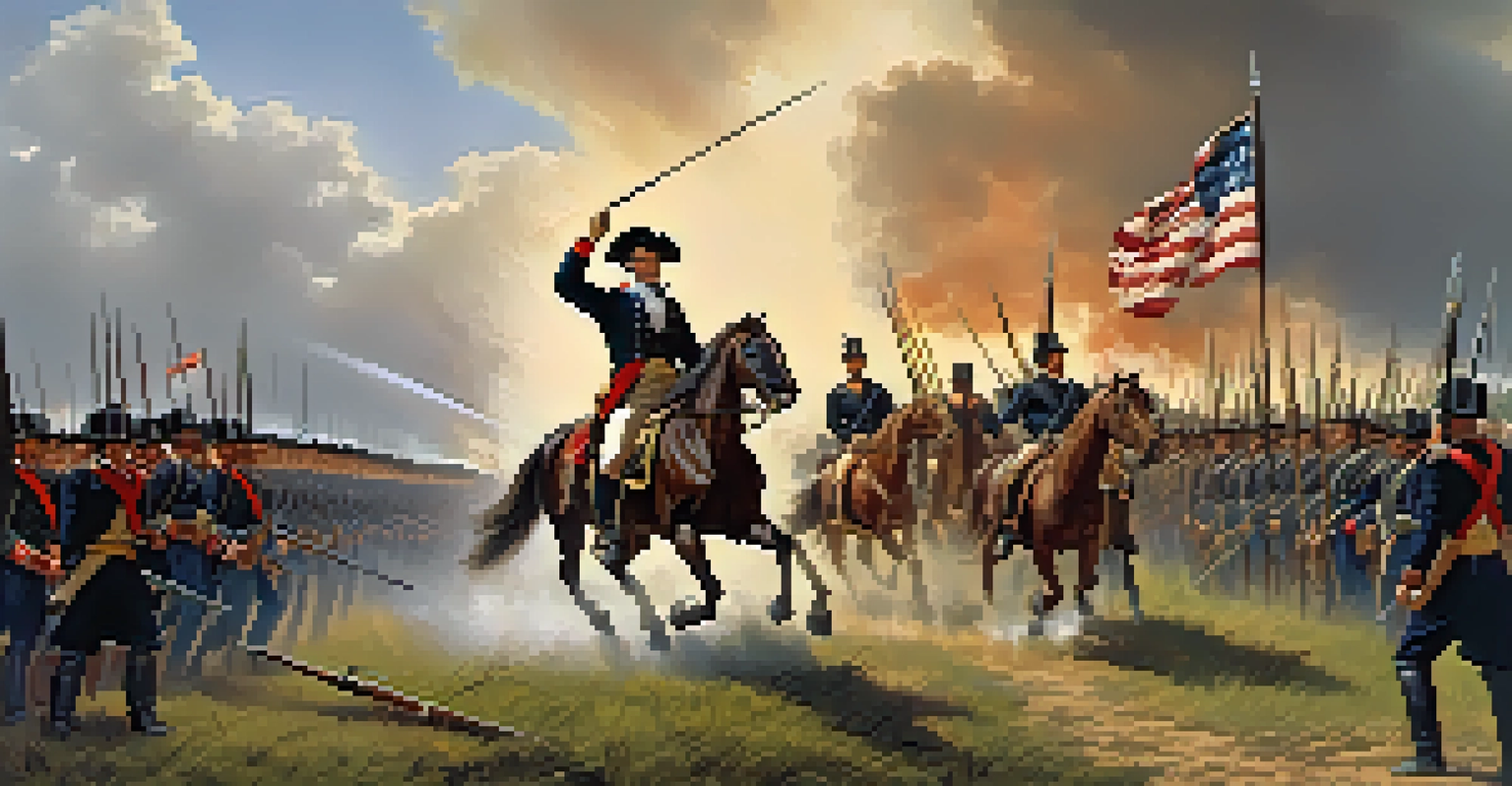The Texas Revolution: A Fight for Independence and Identity

The Roots of the Texas Revolution: A Cultural Clash
The Texas Revolution didn't just arise out of nowhere; it was deeply rooted in cultural and political tensions. By the early 1800s, Texas was a part of Mexico, but many American settlers had moved there, bringing their own customs and ideals. This blend of cultures created a unique identity among Texans, who began to feel increasingly disconnected from Mexican rule.
The battle is not to the strong alone; it is to the vigilant, the active, the brave.
As the Mexican government tightened its grip, enforcing laws that conflicted with the settlers' desires for autonomy, resentment grew. The Texas settlers valued independence and self-governance, while the Mexican authorities pushed for a more centralized control. This cultural clash laid the groundwork for revolution, as Texans sought not just land, but a way of life that honored their beliefs.
Thus, the seeds of the Texas Revolution were sown in this rich tapestry of identity. The desire for independence was fueled not only by politics but by a longing to preserve a way of life that was distinctly Texan. The brewing discontent would soon erupt into a fight for freedom, shaping the course of Texas history.
Key Figures: Heroes of the Texas Revolution
The Texas Revolution was marked by several key figures whose leadership and vision played pivotal roles in the struggle. Sam Houston emerged as a prominent leader, advocating for Texan independence and rallying troops to fight against Mexican forces. His strategic thinking and determination became crucial in the decisive Battle of San Jacinto.

Another notable figure was Stephen F. Austin, often referred to as the 'Father of Texas.' Initially a proponent of negotiation, he later embraced the call for revolution when diplomacy failed. Austin's ability to unite diverse groups of settlers under a common goal was essential in galvanizing support for the independence movement.
Cultural Clash Sparked Revolution
The Texas Revolution stemmed from cultural and political tensions between American settlers and Mexican authorities, leading to a strong desire for independence.
Both Houston and Austin, along with others like William B. Travis and James Bowie, showcased the courage and tenacity that defined the Texas Revolution. Their legacies are remembered not only for their military exploits but also for their commitment to the ideals of liberty and self-determination, which continue to resonate in Texan identity today.
The Spark: From Tensions to Open Conflict
The turning point that ignited the Texas Revolution can be traced back to a series of escalating tensions and events. The infamous 'Lexington of Texas' occurred at Gonzales in 1835, where Texan settlers resisted Mexican troops trying to retrieve a cannon. This confrontation marked a clear declaration that the settlers were no longer willing to accept the Mexican government's control.
Freedom is never free.
As skirmishes erupted, the call for independence gained momentum. The Texan army, comprised of volunteers, began to organize and strategize against the better-equipped Mexican forces. With each battle, from the Siege of Bexar to the Alamo, the resolve of the Texan fighters hardened, fueled by the desire for freedom and self-governance.
The escalation from minor conflicts to a full-scale revolution illustrated the deep-rooted frustrations of the Texan people. The initial spark at Gonzales transformed into a fire that would engulf the region, uniting Texans in a common cause and propelling them towards an inevitable confrontation with Mexico.
The Alamo: A Symbol of Resistance
The Battle of the Alamo in 1836 stands as one of the most iconic events of the Texas Revolution, symbolizing bravery and sacrifice. A small group of Texan defenders, including notable figures like Travis, Bowie, and Crockett, held out against a much larger Mexican force for 13 days. Their stand became a rallying cry for Texan independence, epitomizing the spirit of resistance.
Despite the eventual fall of the Alamo, the battle had profound implications for the revolution. The phrase 'Remember the Alamo!' inspired countless volunteers to join the Texan cause, driving home the message that freedom came at a steep price. This tragic yet heroic moment solidified the determination of Texan forces to avenge their fallen comrades.
Key Figures Led the Fight
Prominent leaders like Sam Houston and Stephen F. Austin played crucial roles in rallying support and advocating for Texan independence during the revolution.
The Alamo transcended its historical significance, becoming a powerful symbol of the fight for liberty. It represented not just a physical battle, but a larger struggle for identity, resilience, and the indomitable spirit of the Texan people, which continues to resonate in Texas culture today.
The Battle of San Jacinto: A Decisive Victory
The culmination of the Texas Revolution came at the Battle of San Jacinto on April 21, 1836, a pivotal moment that changed the course of history. Sam Houston led a surprise attack against General Santa Anna's forces, catching them off guard during a siesta. The Texan army, fueled by vengeance from the Alamo, achieved a stunning victory in just 18 minutes.
This decisive battle not only secured Texan independence but also led to the capture of Santa Anna himself. Under pressure, he signed the Treaties of Velasco, recognizing Texas' sovereignty and effectively ending the conflict. The victory at San Jacinto became a defining moment in the quest for freedom, igniting a sense of pride and unity among Texans.
The triumph at San Jacinto solidified the idea that Texans were willing to fight for their identity and independence. This battle not only marked the end of the revolution but also laid the groundwork for the future of Texas, shaping its identity as a state that values freedom and self-governance.
The Aftermath: Shaping Texas Identity
Following the Texas Revolution, the newly independent Republic of Texas began to forge its identity. The struggle for independence had united diverse groups, creating a shared sense of purpose and pride that transcended cultural differences. This newfound identity was rooted in the principles of liberty, self-determination, and resilience.
However, the aftermath also brought challenges. Texas faced issues such as governance, economic stability, and relations with neighboring nations, particularly Mexico. The struggle for identity continued as Texans navigated their place in a larger geopolitical landscape, balancing their unique heritage with the realities of nation-building.
Legacy of Independence and Pride
The Texas Revolution shaped a unique Texan identity rooted in the values of liberty and resilience, influencing both local culture and global perceptions of self-determination.
As Texas eventually joined the United States in 1845, the legacy of the revolution persisted. The values and spirit that emerged from the struggle for independence continue to influence Texan identity today, reminding residents of their rich history and the sacrifices made for freedom and self-governance.
Legacy of the Texas Revolution: Independence and Pride
The Texas Revolution left an indelible mark on the state's history, shaping the cultural identity of Texans for generations to come. The themes of independence, bravery, and resilience are woven into the very fabric of Texan culture. Commemorative events, like Texas Independence Day, celebrate this legacy, reminding Texans of their unique history and the values they hold dear.
Moreover, the revolution influenced perceptions of identity beyond Texas. It became a symbol of the American spirit of rebellion and self-determination, resonating with movements for independence across the globe. The stories of heroism and sacrifice during the revolution continue to inspire people seeking freedom and justice.

Ultimately, the legacy of the Texas Revolution is one of pride and perseverance. It serves as a reminder that the pursuit of independence is often fraught with challenges, but the spirit of those who fought for freedom endures, shaping the identity of Texas and its people in profound and lasting ways.